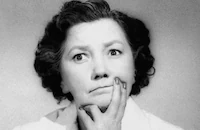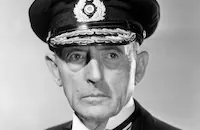The Countess of Monte Cristo
Cast & Crew
Karl Freund
Fay Wray
Paul Lukas
Patsy Kelly
Reginald Owen
Paul Page
Film Details
Technical Specs

Synopsis
Janet Krueger is an extra at a Viennese film studio. She is in love with Stefan, a reporter, but neither makes enough money to support a marriage. She obtains a small part in a film, playing a wealthy Countess traveling in a fashionable car. After the temperamental director criticizes her acting, she drives the automobile off the lot instead of stopping at the studio-built hotel front. She is accompanied by her friend Mimi, who is playing her maid. When they arrive at a luxurious resort, still dressed in their costumes, the two women continue to play their roles, not knowing what else to do. Because a label on her luggage identifies her as the Countess of Monte Cristo, Janet is given a splendid suite. That evening when the police knock on her door, Janet assumes that they have come to arrest her. In fact, they have come to warn her that a thief has broken into her rooms. Finding Janet's closets empty, they assume that the thief has stolen her clothes and the manager offers to replace everything. After they leave, a man called the Baron, who has been hiding in her room, tells Janet that he is the man the police were looking for. Recognizing Janet as another confidence artist, the Baron writes a list of everything he would have stolen if she had owned it. Although Janet is frightened by the ruse, she is delighted with the clothes and jewels when they arrive. Elegantly dressed for dinner, Janet is approached by Rumowski, a mysterious man, who invites her to celebrate New Year's Eve with him. Meanwhile, the Baron proposes that he and Janet set up a racket together and when she refuses, threatens to expose her real identity to the management. Rumowski comes to Janet's aid, unaware that the police have identified him as a famous thief and are surrounding the hotel. When Rumowski notices what is happening, he gallantly offers to distract the police while Janet and Mimi escape. Nonetheless, Janet is arrested along the road. She calls Stefan for help, and after she tells him about Rumowski's capture. Stefan writes a story about Rumowski and Janet's adventures and sells it for a lot of money. The escapade convinces the studio of Janet's acting abilities and they offer her a contract thereby enabling Janet and Stefan to get married.

Director
Karl Freund
Cast

Fay Wray

Paul Lukas

Patsy Kelly

Reginald Owen
Paul Page

Robert Mcwade
Richard Tucker
John Sheehan
Dewey Robinson
Bobby Watson
Harvey Clarke

Frank Reicher
Mathew Betz

Carmel Myers
A. S. Byron
Harvey Clark
Jack Cheatham
Alphonse Martell
George Hackathorne
Crew
Stanley Bergerman
Philip Cahn
Karen Dewolf
Stanley Fleischer
Myrtle Gibson
Phil Karlstein
Norman Krasna
Gilbert Kurland
Gene Lewis
Gene Lewis
M. F. Murphy
Vic Noerdlinger
Maurice Pivar
Earl Snell
Charles Stumar
Gladys Unger
Peggy Vaughn
Edward Ward

Film Details
Technical Specs

Articles
Fay Wray (1907-2004)
She was born Vina Fay Wray, in Cardston, Alberta, Canada on September 15, 1907. Her family relocated to Arizona when she was still a toddler so her father could find employment. When her parents divorced, her mother sent her to Hollywood when Fay's eldest sister died in the influenza epidemic of 1918. The reasoning was that Southern California offered a healthier climate for the young, frail Wray.
She attended Hollywood High School, where she took some classes in drama. After she graduated, she applied to the Hal Roach studio and was given a six-month contract where she appeared in two-reel Westerns (25 minutes in length), and played opposite Stan Laurel in his pre-Oliver Hardy days.
She landed her first big role, as Mitzi Schrammell, in Erich von Stroheim's beautifully mounted silent The Wedding March (1928). It made Wray a star. She then starred in some excellent films: The Four Feathers (1929), the early Gary Cooper Western The Texan (1930), and one of Ronald Coleman's first starring roles The Unholy Garden (1931), all of which were big hits of the day.
For whatever reason, Wray soon found herself in a string of thrillers that made her one of the great screamers in Hollywood history. The titles say it all: Doctor X, The Most Dangerous Game (both 1932), Mystery of the Wax Museum, The Vampire Bat (both 1933) and, of course her most famous role, that of Ann Darrow, who tempts cinema's most famous ape in the unforgettable King Kong (also 1933).
Wray did prove herself quite capable in genre outside of the horror game, the best of which were Shanghai Madness with Spencer Tracy; The Bowery (both 1933), a tough pre-Hays Code drama opposite George Raft; and the brutal Viva Villa (1934), with Wallace Beery about the famed Mexican bandit. Yet curiously, the quality of her scripts began to tank, and she eventually found herself acting in such mediocre fare as Come Out of the Pantry (1935), and They Met in a Taxi (1936).
With her roles becoming increasingly routine, the last of which was the forgettable comedy Not a Ladies Man (1942), she decided to trade acting for domesticity and married Robert Riskin, who won two Best Screenplay Oscars® for the Frank Capra comedies It Happened One Night (1934) and Mr. Deeds Goes to Town (1936). When Riskin died in 1955, Wray found herself working to keep busy and support her three children. She landed supporting parts for films like The Cobweb (1955), Hell on Frisco Bay (1956) and Tammy and the Bachelor (1957). She also found work in television on such popular programs as Perry Mason and Wagon Train before she retired from acting all together in the mid-'60s.
To her credit, Wray did remain reasonably active after her retirement. She published her autobiography, On The Other Hand in 1989 and was attending many film festivals that honored her contribution to film, most notably in January 2003, when, at 95 years of age, she accepted in person her "Legend in Film" Award at the Palm Beach International Film Festival. Wray is survived by a son, Robert Riskin Jr.; two daughters, Susan and Victoria; and two grandchildren.
by Michael T. Toole

Fay Wray (1907-2004)
Quotes
Trivia
Notes
Screen credits were taken from the studio continuity. The continuity notes that Patsy Kelly appeared courtesy of Hal Roach. The Ufa film was directed by Karl Hartl and starred Brigette Helm. In 1948, Frederick de Cordova remade the film for Universal-International, starring Sonja Henie.














